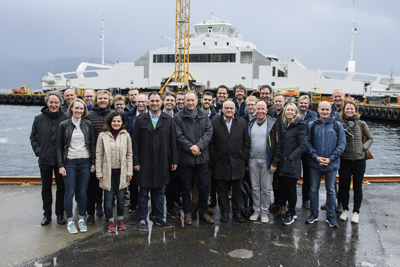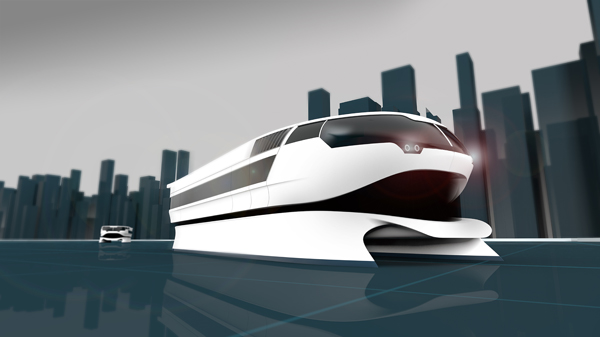A PowerPoint template for the TrAM project has been created. You will find it in the folder Communication & Dissemination – Templates.
Marie Launes
How to create folders and upload documents
Every WP leader is responsible for creating a folder structure within the WP. To create new folder click on the WP folder, then “add folder”. To add a document to a folder click on the folder where you want to place the document, then click “add file”.
Should you require any assistance you can contact Marie Launes, marie@maritimecleantech.no, tel.: +47 976 53 966.
The “LEGO-principle” applied to ship building
The EU project TrAM was officially kicked off in September 2018. It marked the start of a journey towards the world´s first zero emission fast ferry, built through modular production methods.
Four years from now, workers commuting between Stavanger and neighbouring islands will travel silently and emission free by sea. But the legacy of TrAM is much more than a unique zero emission vessel. Through modularization the project will also revolutionize Norwegian production of zero emission vessels.
Funded by the EU
The TrAM project was awarded funding through EU´s Horizon 2020 programme in January 2018. It was a result of years of hard work and successful cooperation between Rogaland County Council and NCE Maritime CleanTech. Together they developed a strong application and hand-picked participants for a strong consortium with actors from both the industry and leading research institutions.
– We are very eager to get started to develop this zero-emission passenger vessel, which will be in operation outside Stavanger from 2022. The project gathers leading European expertise within ship building, propulsion and zero emission technology. We also have several world-leading partners from the research industry, she says.
– The main purpose of the project is to develop new modular manufacturing methods that will reduce the vessel cost by 30 percent. This will make electric-powered high-speed vessel more competitive in terms of both cost and the environment, Hege Økland adds.
High climate and environmental ambitions
The operator of the local route is Kolumbus, a public transport company owned by Rogaland County Council. Kolumbus has ambitious environmental targets for the public transport sector and look forward to cooperating with local and international technology and know-how providers.
– We have people here from Greece, Germany, Scotland, Norway, Belgium and the UK. We have people from the industry and we have bureaucrats like me, in the same room. We need to meet each other, have discussions and clarifications and find out how we are going to do this, Project Manager in the County Council Iver-Jan Leren says.
Will learn from aviation and automotive industries
One of the research institutions involved in the project is Fraunhofer Institute for Industrial Engineering (IAO). The company has developed production methods for large companies such as Volkswagen, Audi and Boeing.
– The project is really interesting for us, because we can adapt methodologies we have used in the aviation and automotive industries and transfer them to the maritime industry, Dr Ing Christoph Jürgenhake of Fraunhofer IAO says.
He explains that their approach to the project is completely different to that of a mechanical designer. The latter would normally start with the shape, while Fraunhofer will start with the functionality and try to modularize the ship to adapt the production technologies.
– What the maritime industry can learn is how to modularize their product structure and architecture. In the maritime industry most ships are built as one-offs, in contrast to planes and cars which are built in larger volumes. Much more effort is put into developing the parts, he says.
“Hydro-powered” fast ferry
The route between Stavanger and the suburb Hommersåk has been operated by local ferries for close to 100 years. For many people the route is an institution, and in only four years’ time the passengers will be among the first in the world to commute via a zero emission fast ferry powered solely by hydro power charged batteries.
– The vessel developed in the TrAM project will be in route from January 2022 and it will be zero emission. The project will be an important enabler for the industry to reduce their costs in the future. I am 100 per cent sure, Iver-Jan Leren of Rogaland City Council says.
Awarded 11.7 Million Euros to develop the next generation high-speed passenger vessel
Rogaland County Municipality and NCE Maritime CleanTech has been awarded 11.7 Million Euros to develop an electric high-speed passenger vessel to operate between Stavanger and Hommersåk on the west coast of Norway. This is one of the largest amounts to have been awarded to a single project in the EU’s Horizon2020 research programme, and the project will revolutionize Norwegian production of zero emission vessels. The project will also conduct two studies for the same type of vessel in London and the inland waterways of Belgium.
Initiator of the project is industry cluster NCE Maritime CleanTech. Rogaland County Municipality is a partner in the cluster, and will, as the owner of the vessel connection and a purchaser of transport services, be the project coordinator. The project will result in a new fully-electric high-speed vessel with zero emissions. In addition, new manufacturing methods will contribute to 25 per cent lower production costs and 70 per cent lower engineering costs. Rogaland County Municipality’s application beat more than 100 other applicants in the competition.
“I’m proud that we receive financial support from the EU. It is an important and major recognition of our collaboration with the industry cluster and vessel operator Kolumbus to develop a zero emission high-speed vessel. This means that Rogaland, Western Norway and Norway, with the county municipality at the forefront, can become a world leader in the development of this type of technology. This is a major contribution to reducing greenhouse gas emissions, which is a focus area for the county municipality as well,” says chairman of the county council Solveig Ege Tengesdal.
The project will also conduct two studies for the same type of vessel in London and Belgium to explore opportunities for similar zero emission vessels on selected routes in Europe. Partners include Thames Clippers, which operates on the Thames River in London.
Will revolutionize Norwegian shipbuilding
Maritime CleanTech encompasses 75 Norwegian companies from the entire maritime value chain and focuses on developing energy-efficient and environmentally friendly solutions for the maritime industries.
“This is a big day for the cluster and our partners, and an important recognition of our leading position within green and smart solutions for the ocean industrien. The project is revolutionary both in terms of zero emission technology and manufacturing methods, and will strengthen the participants’ competitiveness both nationally and internationally. It will also contribute to making electric-powered high-speed vessel competitive in terms of both cost and the environment,” says Hege Økland, General Manager, NCE Maritime CleanTech.
The Rogaland county municipality will contribute with NOK 5 million to a demonstration vessel, and has committed to putting int into service between Stavanger and Hommersåk. The vessel will be operated by Kolumbus and accommodate 150 passengers and 20 bicycles. It will operate at a speed of 23 knots.
A result of good collaboration
The Norwegian players who will contribute to developing the vessel are all members of Maritime CleanTech. Besides Rogaland County Municipality they are Leirvik, Fjellstrand, Servogear, Wärtsilä and Hydro Extrusions Norway. Valide and Kolumbus have also taken part in the project. The vessel will be built by Norwegian shipyard Fjellstrand.
“This is an important project for several reasons. By implementing battery technology the Norwegian ferries are at the forefront of the green shift, and now we are bringing this technology to the high-speed vessel market. Norwegian shipyards are experiencing tough international competition, and by reducing production costs we will become far more competitive,” says Edmund Tolo, Sales Manager, Fjellstrand.
The project is also supported by the Research Council of Norway and Innovation Norway.
“The Research Council is impressed and proud of Rogaland County Municipality and Maritime CleanTech who have succeeded in competing for coveted EU funds. These funds are only distributed to Europe’s finest. Many Norwegian enviorments are fore runners, both in the public and private sector, and we would encourage more to follow Rogaland’s example of collaboration,” says the Research Council’s International Director Kristin Danielsen.
“This is a result of targeted and strategic work over time by a forward leaning industry cluster. Maritime CleanTech saw the opportunities in Horizon2020 at an early stage, and really deserves to succeed with its project, says Mona Skaret, Director Private and Public Innovation, Innovation Norway.
The following are also taking part in the project: Wärtsilä Holland (Netherlands), MBNA Thames Clippers (UK), University of Strathclyde (UK), Fraunhofer IEM (Germany), HSVA (Germany) and Waterwegen & Zeekanal NV (Belgium).
The project will commence on Spetember 1 when the contract with the European Commission has been signed and it has a duration of four years. The value of the allocation is 11,741,643.


